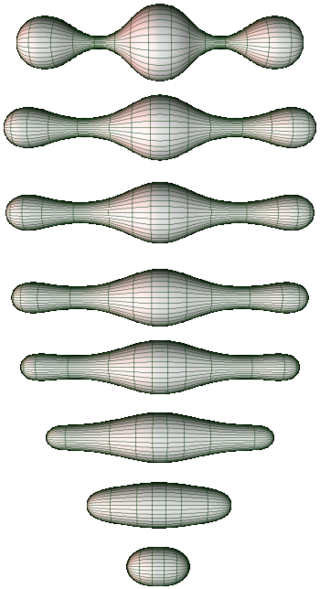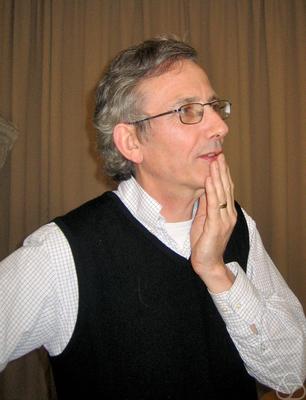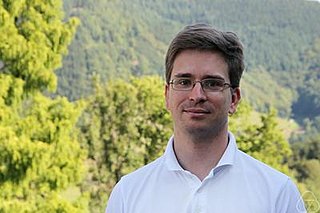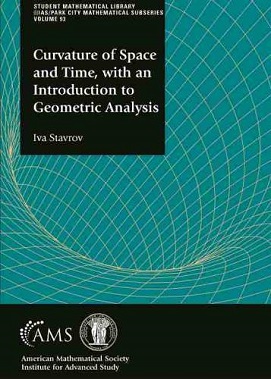Related Research Articles

Riemannian geometry is the branch of differential geometry that studies Riemannian manifolds, smooth manifolds with a Riemannian metric, i.e. with an inner product on the tangent space at each point that varies smoothly from point to point. This gives, in particular, local notions of angle, length of curves, surface area and volume. From those, some other global quantities can be derived by integrating local contributions.
In the mathematical field of Riemannian geometry, the scalar curvature is a measure of the curvature of a Riemannian manifold. To each point on a Riemannian manifold, it assigns a single real number determined by the geometry of the metric near that point. It is defined by a complicated explicit formula in terms of partial derivatives of the metric components, although it is also characterized by the volume of infinitesimally small geodesic balls. In the context of the differential geometry of surfaces, the scalar curvature is twice the Gaussian curvature, and completely characterizes the curvature of a surface. In higher dimensions, however, the scalar curvature only represents one particular part of the Riemann curvature tensor.

In the mathematical fields of differential geometry and geometric analysis, the Ricci flow, sometimes also referred to as Hamilton's Ricci flow, is a certain partial differential equation for a Riemannian metric. It is often said to be analogous to the diffusion of heat and the heat equation, due to formal similarities in the mathematical structure of the equation. However, it is nonlinear and exhibits many phenomena not present in the study of the heat equation.

Shing-Tung Yau is a Chinese-American mathematician and the William Caspar Graustein Professor of Mathematics at Harvard University. In April 2022, Yau announced retirement from Harvard to become Chair Professor of mathematics at Tsinghua University.
In the mathematical field of differential geometry, Ricci-flatness is a condition on the curvature of a (pseudo-)Riemannian manifold. Ricci-flat manifolds are a special kind of Einstein manifold. In theoretical physics, Ricci-flat Lorentzian manifolds are of fundamental interest, as they are the solutions of Einstein's field equations in vacuum with vanishing cosmological constant.
In the mathematical field of differential geometry, there are various splitting theorems on when a pseudo-Riemannian manifold can be given as a metric product. The best-known is the Cheeger–Gromoll splitting theorem for Riemannian manifolds, although there has also been research into splitting of Lorentzian manifolds.

Sir Simon Kirwan Donaldson is an English mathematician known for his work on the topology of smooth (differentiable) four-dimensional manifolds, Donaldson–Thomas theory, and his contributions to Kähler geometry. He is currently a permanent member of the Simons Center for Geometry and Physics at Stony Brook University in New York, and a Professor in Pure Mathematics at Imperial College London.

Richard Melvin Schoen is an American mathematician known for his work in differential geometry and geometric analysis. He is best known for the resolution of the Yamabe problem in 1984.

Geometric analysis is a mathematical discipline where tools from differential equations, especially elliptic partial differential equations (PDEs), are used to establish new results in differential geometry and differential topology. The use of linear elliptic PDEs dates at least as far back as Hodge theory. More recently, it refers largely to the use of nonlinear partial differential equations to study geometric and topological properties of spaces, such as submanifolds of Euclidean space, Riemannian manifolds, and symplectic manifolds. This approach dates back to the work by Tibor Radó and Jesse Douglas on minimal surfaces, John Forbes Nash Jr. on isometric embeddings of Riemannian manifolds into Euclidean space, work by Louis Nirenberg on the Minkowski problem and the Weyl problem, and work by Aleksandr Danilovich Aleksandrov and Aleksei Pogorelov on convex hypersurfaces. In the 1980s fundamental contributions by Karen Uhlenbeck, Clifford Taubes, Shing-Tung Yau, Richard Schoen, and Richard Hamilton launched a particularly exciting and productive era of geometric analysis that continues to this day. A celebrated achievement was the solution to the Poincaré conjecture by Grigori Perelman, completing a program initiated and largely carried out by Richard Hamilton.
In the mathematical field of differential geometry, the existence of isothermal coordinates for a (pseudo-)Riemannian metric is often of interest. In the case of a metric on a two-dimensional space, the existence of isothermal coordinates is unconditional. For higher-dimensional spaces, the Weyl–Schouten theorem characterizes the existence of isothermal coordinates by certain equations to be satisfied by the Riemann curvature tensor of the metric.
In Riemannian geometry, a branch of mathematics, harmonic coordinates are a certain kind of coordinate chart on a smooth manifold, determined by a Riemannian metric on the manifold. They are useful in many problems of geometric analysis due to their regularity properties.
In differential geometry, a Kähler–Einstein metric on a complex manifold is a Riemannian metric that is both a Kähler metric and an Einstein metric. A manifold is said to be Kähler–Einstein if it admits a Kähler–Einstein metric. The most important special case of these are the Calabi–Yau manifolds, which are Kähler and Ricci-flat.

Thierry Aubin was a French mathematician who worked at the Centre de Mathématiques de Jussieu, and was a leading expert on Riemannian geometry and non-linear partial differential equations. His fundamental contributions to the theory of the Yamabe equation led, in conjunction with results of Trudinger and Schoen, to a proof of the Yamabe Conjecture: every compact Riemannian manifold can be conformally rescaled to produce a manifold of constant scalar curvature. Along with Yau, he also showed that Kähler manifolds with negative first Chern classes always admit Kähler–Einstein metrics, a result closely related to the Calabi conjecture. The latter result, established by Yau, provides the largest class of known examples of compact Einstein manifolds. Aubin was the first mathematician to propose the Cartan–Hadamard conjecture.
The Yamabe problem refers to a conjecture in the mathematical field of differential geometry, which was resolved in the 1980s. It is a statement about the scalar curvature of Riemannian manifolds:
Let (M,g) be a closed smooth Riemannian manifold. Then there exists a positive and smooth function f on M such that the Riemannian metric fg has constant scalar curvature.

Shoshichi Kobayashi was a Japanese mathematician. He was the eldest brother of electrical engineer and computer scientist Hisashi Kobayashi. His research interests were in Riemannian and complex manifolds, transformation groups of geometric structures, and Lie algebras.
In the mathematical field of differential geometry, the Paneitz operator is a fourth-order differential operator defined on a Riemannian manifold of dimension n. It is named after Stephen Paneitz, who discovered it in 1983, and whose preprint was later published posthumously in Paneitz 2008. In fact, the same operator was found earlier in the context of conformal supergravity by E. Fradkin and A. Tseytlin in 1982 (Phys Lett B 110 117 and Nucl Phys B 1982 157 ). It is given by the formula
In mathematics, Salomon Bochner proved in 1946 that any Killing vector field of a compact Riemannian manifold with negative Ricci curvature must be zero. Consequently the isometry group of the manifold must be finite.

Simon Brendle is a German mathematician working in differential geometry and nonlinear partial differential equations. He received his Dr. rer. nat. from Tübingen University under the supervision of Gerhard Huisken (2001). He was a professor at Stanford University (2005–2016), and is currently a professor at Columbia University. He has held visiting positions at MIT, ETH Zürich, Princeton University, and Cambridge University.

Curvature of Space and Time, with an Introduction to Geometric Analysis is an undergraduate-level textbook for mathematics and physics students on differential geometry, focusing on applications to general relativity. It was written by Iva Stavrov, based on a course she taught at the 2013 Park City Mathematics Institute and subsequently at Lewis & Clark College, and was published in 2020 by the American Mathematical Society, as part of their Student Mathematical Library book series.
References
- ↑ "Research Papers, John M. Lee". Mathematics Department, U. of Washington.
- 1 2 3 4 "John M. Lee, C.V." Mathematics Department, U. of Washington.
- ↑ John Marshall Lee at the Mathematics Genealogy Project
- ↑ Jackson, Allyn (April 2013). "Jerison and Lee Awarded 2012 Bergman Prize" (PDF). Notices of the AMS. 60 (4): 497–498.
- ↑ Hunacek, Mark (March 31, 2011). "Review of Introduction to topological manifolds, 2nd edition, by John M. Lee". MAA Reviews, Mathematical Association of America.
- ↑ Berg, Michael (October 11, 2012). "Review of Introduction to smooth manifolds, 2nd edition, by John M. Lee". MAA Reviews, Mathematical Association of America.
- ↑ "Review of Fredholm operators and Einstein metrics on conformally compact manifolds by John M. Lee". European Mathematical Society. June 8, 2011.
- ↑ Hunacek, Mark (May 30, 2013). "Review of Axiomatic geometry by John M. Lee". MAA Reviews, Mathematical Association of America.